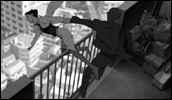Paprika
- Year
- 2006
- Original title
- Papurika
- Japanese title
- パプリカ
- Director
- Cast
- Running time
- 90 minutes
- Published
- 18 January 2008



by Paul Jackson
When Perfect Blue, Satoshi Kon's debut feature, was released to a fari deal of fanfare in 1998 it prompted B-movie maven Roger Corman to draw comparisons with Alfred Hitchcock. Following the release of Paprika, Kon's fourth theatrical film, it appears that Corman's comment is perhaps even more revealing than originally intended. Although Paprika doesn't reflect any direct Hitchcock influence, it does continue Kon's fascination with the division of reality and fantasy, itself symptomatic of a post-modern collapse of reality whose origins in popular cinema arguably stem from Hitchcock's Vertigo (1958). That said, Kon has developed these themes and images way beyond Vertigo, due in no small part to his chosen medium of anime.
Based on the novel by Yasutaka Tsutsui, Paprika takes place following the theft of the DC Mini. Developed as part of a groundbreaking psychiatric treatment, this device allows specialists to enter patients' unconscious thoughts in hopes of identifying and curing their neuroses - "the scientific key that allows us to open the door to our dreams." The implications of its disappearance are devastating. As people begin to experience waking dreams, sometimes with deadly consequences, Atsuko Chiba, a researcher heavily involved in the DC Mini project, begins a search that crosses the increasingly blurred boundaries between real life and dreams.
Kon told Midnight Eye that he contemplated adapting Tsutsui's novel immediately after completing Perfect Blue. Considered alongside Millennium Actress (2001) and Tokyo Godfathers (2003), Kon's second and third features respectively, it is easy to understand the appeal (though Kon also directed the anime TV series Paranoia Agent (2004) which shares many of the same themes and techniques as his feature films). Perfect Blue followed the naively innocent Mima as she made the leap from J-pop starlet to TV actress. Throughout the film Mima is encouraged to shed her pop star image. Her roles become increasingly challenging, culminating in a violent rape scene that throws her identity into crisis. Mima's inner turmoil is masterfully visualised: as her conflicting identities interchange and interact, Kon deliberately avoids any transition scenes ensuring that the 'real' Mima and her mental projections become gleefully intertwined.
Kon resumed this technique in Millennium Actress. Chiyoko is a retired star of Japanese cinema's Golden Age. Approached by an enthusiastic journalist and his dutiful cameraman, she reflects upon her career and personal life. As Chiyoko recounts a tale of lost love and her attempts to recapture it, her real-life persona and fictional alter egos merge into a singular narrative. Kon further blurs the boundaries of fact and fiction by allowing Chiyoko's interviewers to appear and interact within the settings of her period films.
Tokyo Godfathers, the tale of three homeless down-and-outs who discover a baby dumped in a rubbish heap, initially appears to deviate from Kon's established themes. It certainly doesn't explore the division of reality and fantasy in the same depth, but flourishes remain. In one revealing scene, a homeless girl remembers the incident that caused her to run away from home - she badly injures her father with a knife. As the scene progresses her parents are replaced by her surrogate homeless family and the abandoned child is adorned with radiant wings. Elsewhere, a badly beaten old man collapses before a vision of a glowing guardian angel.
Paprika's central premise not only allows Kon to resume these recurrent themes but also to develop them considerably. Like Mima and Chiyoko before her, Atsuko has a fictional alter ego: Paprika, a sprightly young woman able to enter the dreamscapes of Atsuko's patients. From the outset, the boundary between Atsuko and Paprika, real and imaginary, is tenuously defined. After using the DC Mini to examine a patient's dreams, Paprika returns to the Foundation for Psychiatric Research - initially she rides a rocket sprung from the two-dimensional logo of a passing lorry, later she dances from the confines of one billboard to the next. Finally she 'freezes' the world to halt the endless cycle of oncoming traffic, before at last arriving at her destination, composed and refined, as Atsuko. For Kon this is business as usual.
By the film's climax the division of reality and fantasy has all but disappeared. Individual dreams merge into a unanimous explosion of absurd, carnivalesque surrealism that frightens and thrills in equal measure. The impossible becomes possible: Paprika hurtles into a television screen only to gracefully spring from the lens of the recording camera; a giant baby tears through an office block as a parade of kitchen appliances march by unperturbed.
The sense of an impending collapse of reality is further highlighted by Kon's post-modern allusions to the mechanisms and history of cinema. In addition to Atsuko's search, detective Toshimi Konakawa is conducting his own investigation into the DC Mini's theft. Haunted by dreams of a circus troupe of distorted doppelgangers, Konakawa repeatedly plummets through a breakneck dream sequence of generic Hollywood scenarios: he swings Tarzan-like under a jungle canopy, tussles aboard a careening train, and photographs a dysfunctional get-together. Tellingly, Paprika uses films as an analogy for dreams. Here, it seems Hollywood's dream factory reaches far beyond the multiplexes.
Furthermore, the genesis of Konakawa's recurring dream is later revealed to stem from his teenage experiences as an amateur filmmaker. Images from his only 8-mm short have become entangled with details of a real life homicide. Later Konakawa visits a movie theatre where events taking place in a dream are playing on screen: in one of the film's more menacing scenes, Paprika is pinned to an examination table as a probing hand snakes under her skin. Konakawa forces himself through the cinema screen, frees Paprika and kisses her to rapturous applause. As in the films he was subconsciously re-enacting, Konokawa assumes the role of the hero and, as a result, eventually cures his neuroses. Films, dreams and reality overlap repeatedly.
Kon began his career as a background artist (Roujin-Z, Patlabor 2, Memories) renowned for injecting a staggering level of lived-in detail into each of his compositions. Take, for example, the apartment of Paprika's prime suspect: toys are piled in mountainous heaps, cables flow freely from electrical appliances, dishes sit unwashed in an unkept sink, and assorted debris litters the floor to wonderful effect. Throughout his features Kon has also developed a keen ability to utilize live-action cinematic techniques leading many to question his choice of medium. Why anime? Simply put, anime allows Kon a seamless blend of the real and unreal. From Perfect Blue onwards, the juxtaposition of meticulously detailed realism with flourishes of the surreal has become a hallmark of Kon's work. Mundane everyday events sit tantalisingly close to terrifying descents into the mind and exhilarating leaps into the unknown. Deftly shifting between the two is perhaps Kon's greatest strength as a filmmaker.